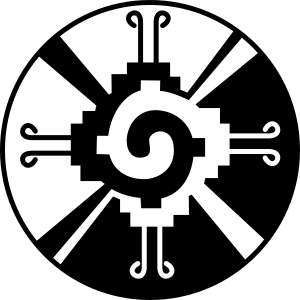Hunab Ku facts for kids
Hunab Ku (pronounced hoo-nahb koo, also spelled Junab K'uj) is a term from the Yucatec Maya language. It means "The One God." This term was used during the time when the Spanish arrived in the Americas. It helped explain the Christian idea of one God to the Maya people, who had many gods.
People sometimes talk about Hunab Ku in New Age beliefs, especially through the work of José Argüelles.
Hunab Ku: The Christian God
The first time "Hunab Ku" was written down that we know of was in a dictionary from the 1500s called Diccionario de Motul. It said "Hunab-ku" was "the only living and true god." It also said this god had no shape because he was a spirit and could not be drawn.
The term "Hunab Ku" also appears in the Book of Chilam Balam of Chumayel. This book was written after the Spanish Conquest. However, you won't find "Hunab Ku" in any ancient Maya writings from before the Spanish arrived.
Some people, like Sylvanus Morley, thought Hunab Ku was the main god of the ancient Maya. But today, most experts who study the Maya don't agree with this idea. They believe "Hunab Ku" was a term created to help teach Christianity to the Maya. For example, a language expert named William Hanks says that "hunab ku" was made up during the time missionaries were teaching the Maya. It was a way to talk about the Christian God.
Hunab Ku in New Age Ideas
Modern ideas about Hunab Ku in New Age beliefs come from the work of Mer Domingo Martínez Parédez. He first shared his thoughts in 1953. Martínez believed Hunab Ku showed that the Maya believed in one god, like Christians do.
He also thought Hunab Ku was shown by symbols like a square inside a circle or a circle inside a square. He said the square meant measurement and the circle meant movement. Martínez even connected Hunab Ku to ideas and symbols used in Freemasonry, like the "Great Architect of the Universe." He also linked Hunab Ku to the phrase "In Lak'ech," which he said meant "You are my other I."
These ideas from Martínez became popular thanks to people like Hunbatz Men and José Argüelles.
Hunab Ku as a Symbol
José Argüelles helped make the Hunab Ku idea popular in his 1987 book The Mayan Factor. He learned about it from Hunbatz Men. However, the symbol Argüelles used for "Hunab Ku" was not the one Martínez suggested.
Argüelles' symbol was actually an old rectangular design used by the Aztecs for a special cloak. This design is still used today in rugs sold in central Mexico. Argüelles connected this design to the Milky Way galaxy and the god Hunab Ku. He changed the symbol to look more like a circle, similar to a yin and yang symbol or a spiral galaxy.
The earliest known place this design appeared is in the 1500s Codex Magliabechiano. This is an Aztec document, not a Maya one. The design was first shown to the public by Zelia Nuttall in her 1901 book.
Later, in 1976, the design was introduced to weavers in Oaxaca, Mexico. Argüelles said he bought rugs with this design. He then changed it and made it famous in his book and during an event called the 1987 Harmonic Convergence.
The design also appeared in a novel from 1914 called The House of the Dawn. The book's artist likely found the Aztec design in Nuttall's earlier publication. Another writer, John Major Jenkins, later used parts of this design in his own writings.
It's important to know that even though Martínez, Argüelles, and Jenkins talked about it, there are no known ancient Maya artworks or writings that show a symbol for "Hunab Ku." The symbol that became popular is actually an Aztec design.
See also
 In Spanish: Hunab Ku para niños
In Spanish: Hunab Ku para niños
- Mayanism


